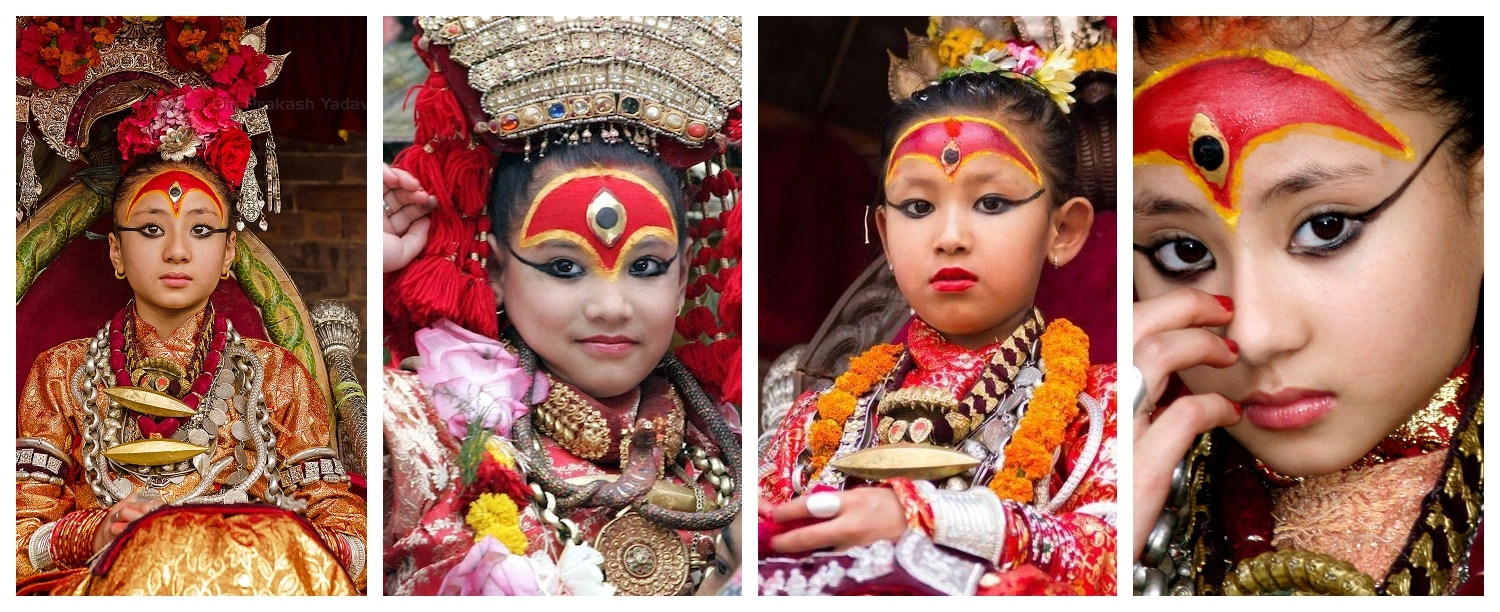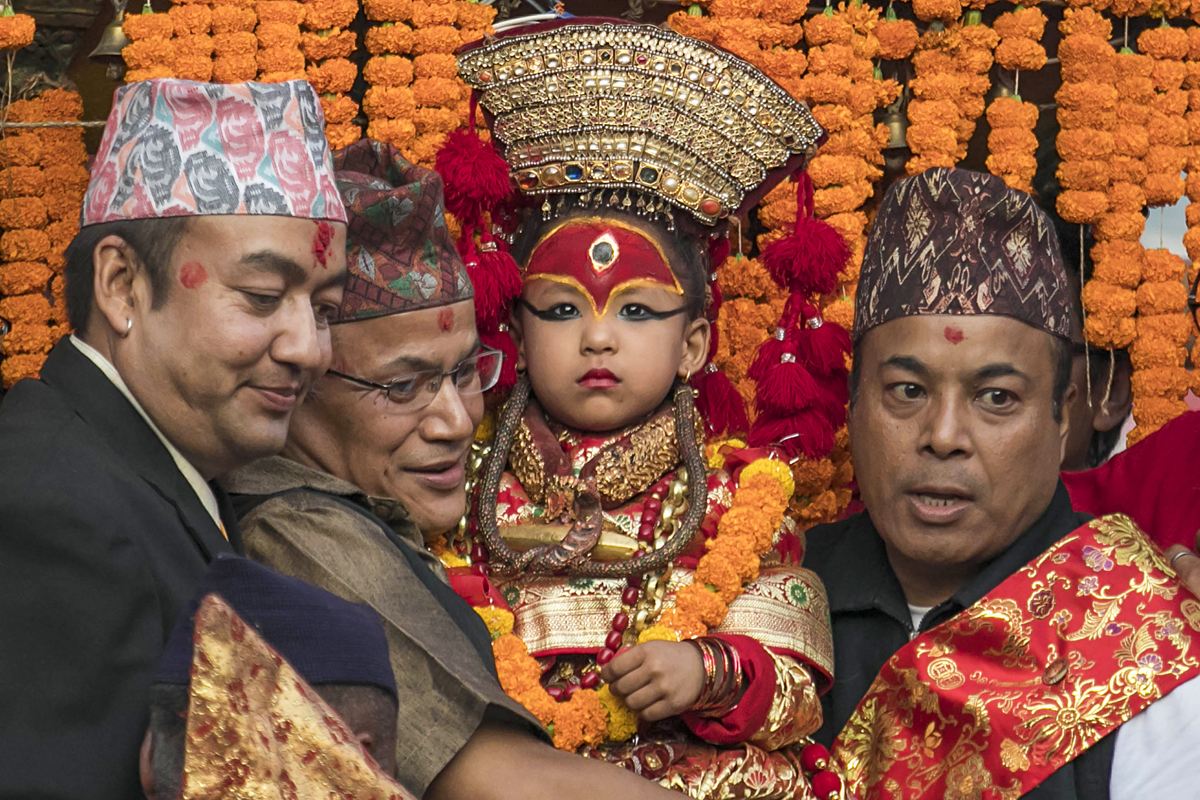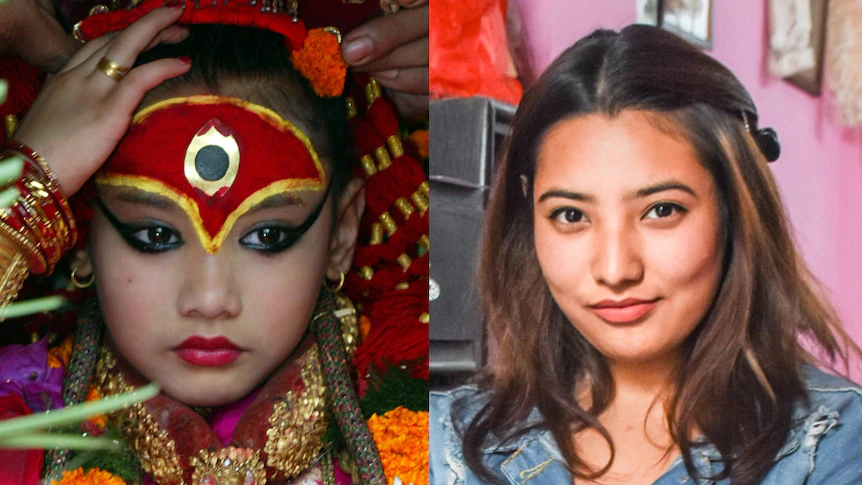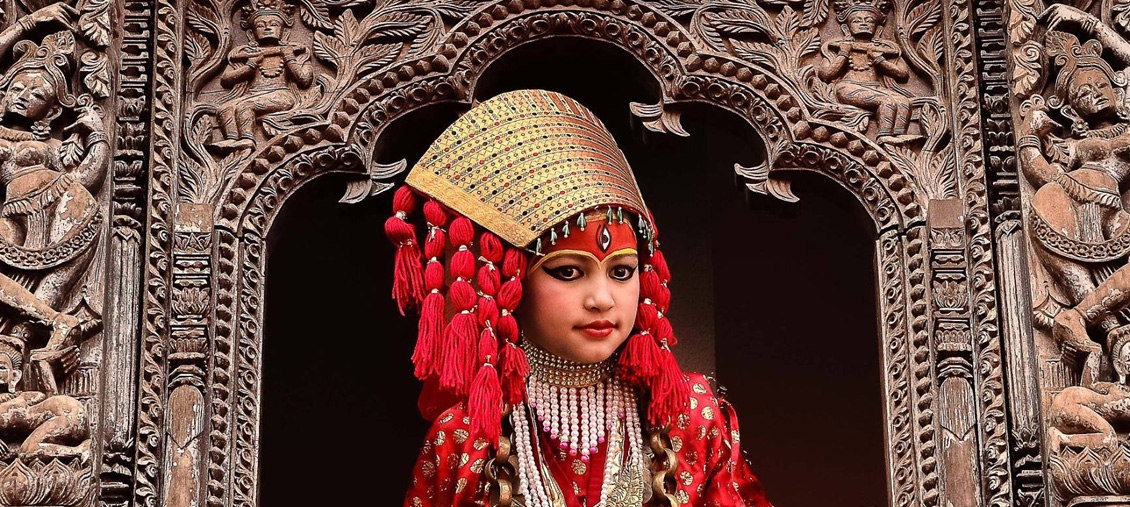Kumari Culture : A Sacred Tradition of Kathmandu valley in Nepal, the country of older religion and spirituality, is also the home of the world’s strangest living ritualthe Kumari goddess, or Living Goddess. The flesh-and-blood embodiment of earth womanhood, the Kumari is an early-teen girl who must endure a stringent ordeal of selection and also be deified in crown ceremonies, celebration, and everyday living.
Not only has this magical tradition attracted cultural tourists, but also anthropologists. But under the sacred image lies a more profound, at times chilling, reality—one that challenges deep questions concerning children’s rights; children’s shaping and social resocialization; tradition and modernity conflict.
Here in this blog we sketch out the Kumari culture of Nepal fairly broadly: its origins; rituals; festivals; tourist participation; and some of the ethical issues it raises. If you are planning a cultural tour of Kathmandu or if you simply wish to be aware, you may wish to refer to this as a handbook to one of the last cultures on earth of live goddesses.

The Origins of the Kumari Culture
Kumari tradition has its roots very deep into the past, to even the initial part of the 17th century, when it was the era of the Malla dynasty. Among all Hindu and Buddhist religions, the Kumari began from the cult of Taleju Bhawani and the Tantric goddess. It is said to trace back a very long way after it is said once upon a time that King Jayaprakash Malla lost a game of chance to Taleju in bed.
When this was made known, Taleju took an oath of revenge to the King that she would only come back as a girl child of the Shakya or Bajracharya caste, the Kathmandu Newar Buddhists. This resulted in a trend toward the cult of adoration of a girl of a very young age as the true incarnation of Taleju. Kumari culture, developed over centuries, is a blend of religious devotion, royalty, and Newar culture within an ascending spiritual experience.
How a Living Goddess is Chosen
Being a Kumari is not an ordinary job; it is an occult and spirituality-laden hiring process, and involves astrologers, priests, and royal advisors.
The selection is ideal; the bride-to-be must be of the Shakya or Bajracharya caste, have a virgin body, and also must have some of the goddess like qualities of the “32 perfections of a goddess.” They have such physical characteristics as “eye,” “deer’s legs,” and “lion-like chest.” The last step in the selection process is a spine-chilling initiation ceremony called the Kal ratri test, in which the candidates are taken to a black room packed with animal skulls and ritual blood, and the girl who never shuts her eyes is thought to have Taleju’s innocent soul.
After the selection, Kumari is removed from the world to live at the Kumari Ghar, goddess palace in Kathmandu Durbar Square, and becomes adjusted to goddess life.
The Daily Life of the Living Goddess
The everyday life of the living goddess, the Kumari, of Nepal is unsettled by ritual purity, complete isolation, and flawlessly symbolic religious significance. With her selection as early as the age of 2–5 years old, the Kumari says goodbye to the birth home and begins her goddess life at the Kumari Ghar (goddess house), the ritual house in Kathmandu Durbar Square. The Kumari’s role is symbolic in and of itself, as the devotees consider that Taleju (the goddess she incarnates) is present in her body.
Ritual Purity and Elemental Prohibitions
The Kumari is regarded as a pure vessel of divine energy. For each desire uttered to her, the utmost precautions are taken to ensure her purity:
Never touch the ground: Outside palace grounds, she never gets to touch the ground with her feet. She is handled by her servants/her servants will carry her, or carried in a palanquin, especially if there are celebrations. This is possibly because touching the ground would get in the way of her life as a goddess.
None but the elect can touch her: her personal servants, nursemaids, and priests can approach to invoke ritual. Anyone who touches her in a presumptuous manner or without proper means and ritual purity is presumptuous towards the goddess.
Outer appearances count: She appears every day in ritual red attire with ritual cosmetics such as agni chakchuu (the eye of fire) on her forehead and golden traditional ornaments. These are not adornments, but to remind us of the goddess every day.
She’s worshipped daily and offered:
The Kumari is revered and offered puja nearly daily by priests, caretakers, and visitors. There is a daily morning ceremony at the Kumari Palace.
She is first attended to by her caretakers (Chitaidar and the other assistants) to bathe, dress, and eat (vegetarian and offered with full ritual cleanliness).
On her birthday, pilgrims who visit the Kumari palace visit daily and pray and give offerings. She silently sits on her throne for the day as groups of people half-bow and give offerings or make other offerings to her, quietly looking in her direction. People believe that she can foretell the future by gazing at her or rid them of evil fortune.
In sheer devotion of worship and respect, priests come to her every day to recite mantras and perform religious rituals on her behalf, and as other divine blessings to her, ordaining the Kumari as sacred.

Public Activities: Festivals and Chariot Processions
The Kumari has comparatively little public activity. The most visible public activity is during Indra Jatra, one of the biggest festivals in Kathmandu:
- Indra Jatra’s Kumari is brought out in a high, elaborately decorated wooden chariot and paraded before Kathmandu’s streets.
- She blesses the King (by tradition), government officials, and thousands of ordinary people who have come for a glimpse of her.
- The people gaze with keen eyes at her behavior at such processions, and if she is lucky enough to be quiet and calm it is a very auspicious sign for the year.
- Dashain, Kumaripuja, and Navaratri are some of the significant occasions. The Kumari can visit such festivals in a bid to become involved in special rites, to bathe Tika, and/or to receive state visits.
Education, Loneliness, and Emotional Consequences
In the best of all worlds a goddess, her most basic human needs are assail time and again: “Education, Loneliness, and Emotional Consequences”
Education: Her education has been restricting according to the traditional norms. She has been educated with restricted education in the palace without any possibility of attending normal schools. The Nepalese government and NGOs have attempted their best during the recent past to provide home schooling such as reading, writing, mathematics, and social studies for Kumaris.
Social life: She is not permitting a normal social life, i.e., play or play sport, or indulge in childhood joys. Even going out twice or thrice to meet relations is not permitted, and her “friends” are orderlies and some, old Kumaris if they happen to drop in.
Psychological impacts: While there are accounts of earlier Kumaris of the psychological misery they experience as isolate, identity-crisis-stricken, and realizing that they would then have to learn new coping mechanisms no longer goddess, effortless healthy emotional transition from goddess to mere girl hurts and confounds without professional psychological support.
Though deified, worshipped, and symbolically invested in culture, Kumari exists in a life tightly circumscribed, segregated, and predetermined. A god or goddess, the child remains human child who will be forced to exist in impossible expectation and limitations.
For all such excursions into equilibrium to Kumari life, in the form of additional education, health breaks from time to time, and more family time for the Kumari, Kumari life is rich tapestry of restraint, ritual, and respect.
Life After Retirement: Mortal Rather Than Goddess
- A Kumari retires upon blood being pushed into circulation by coincidence or menstruation. She is then nothing but an ordinary citizen – at least on paper if not in fact.
- The majority of the ex-Kumaris are emotionally traumatized, stunned, and identity-crisis-ridden. Even marriage with an ex-Kumari was a sorrowful wedding, thus their alienation as Kumari. Although that is receding now its psychological impact cannot be erased.
- A couple of the former Kumari have spoken out, most recently suggesting better education, better mental health and transition arrangements at retirement.

Tourist Experience: How to Gaze Respectfully Experience Kumari Culture
Thoughtful travelers will discover that a meeting with the Kumari will be one of those magical once-in-a-lifetime experiences. Kumari Ghar in Kathmandu Durbar Square is open, and the goddess can be seen by anyone at some points during the day.
Some ethical encounter tips are:
- Respect: Soft clothes, no flash, and muted.
- Don’t make her a spectacle: Attend the meeting as you would any sacred ritual/tradition.
- Responsible tourism: Support considerate guides/agencies/friends in adjusting to cultural rituals.
- Timing is everything: Remember Indra Jatra (September) is the optimal time to spot Kumari in public.
Major Events Where you will catch a glimpse of Kumari
1. Indra Jatra
Her most public manifestation is Indra Jatra. Indra Jatra is the Hindu celebration of god Indra. Kumari is street borne on Kathmandu streets by golden carriage, and pilgrims who are thousands stand in line to be blessed by her.
2. Dashain
The Kumari is not part of general, everyday Dashain rituals but her devotees do fill the Kumari in dress during Dashain and feel that they can receive her blessings.
3. Kartik Nach and other local jatras
In addition to Dashain and Indra Jatra, there are numerous small festivals in and surrounding the Kathmandu Valley where one sees performance of the Kumari demonstrate how much a part of Newar daily life Kumari is.
The Dark Side: Psychological and Ethical Issues of Kumari
Despite Kumari culture being very much a part of Nepal’s culture, there are certain issues raise by some psychologists and certain human rights groups. Some of the major issues are explain below.
Yes. Below are the detailed descriptions of each of the darker side elements of the Kumari tradition, two paragraphs each about each side regarding creating more awareness and cultural sensitivity.
1. Loss of Childhood
While the Kumari is revered, her life is otherwise describe as a loss of childhood. Once she is select, according to age, she is taken from school, from a typical child life, to be adopt at Kumari Ghar and live there in extremely disciplined religious living; she won’t have a chance to play, not the type most kids are allowed to play, she won’t have the opportunity to have regular school (once more, whatever Kumari Ghar that might be) and she won’t even be allow to mingle with children just the same.
Her existence is dominated by religious ceremonies, rituals, and disciplining of her soul every day. Although she would be worshiped devoutly and with reverence, her life and self would be cult devotion-oriented instead of being hers. This detachment from everyday social life denies Kumaris valuable developmental experiences. In the lack of peer attachment, play, and informal learning settings, the Kumari is denied basic social and emotional learning.
Even with education reforms which have allowed Kumaris to receive some private tutoring more and more, these are additions to an end education and social curriculum. What became of childhood as a little girl, with fantasy, discovery and innocence, to be replace by exclusion and seriousness in a package, to say nothing of God-ordained standards of perfection.
2. Psychological Consequences for Kumari
Divinity in childhood’s early years may lead to sudden identity change. Kumaris are never refer to as anything but a goddess by the adults that surround them, treat like doll children by adults and shield from the customary contact of people. Their attain role is strip from them when they enter menopause. Goddess to zero role reversal could be disastrous. All of the Kumaris have also declare that they have been depress, bewilder, and left behind in attempting to re-acclimate back (re-enter back) into a completely new world that previously was completely absorb in what it means to be a Kumari but now looks at them from a distance. Human rights defenders and psychologists think that such a broad closure without retaining the mental health center in their jurisdiction. It would subject children to psychological traumas, which would take centuries to be forget.
The very same young woman who formerly reigned in the genuine adoration. For instance, five hundred a day on an altar (i.e., not scraped off a pail) might now be compell to hustle to be a friend, learning in a schoolroom, or even talking with and participating with individuals other than on her altar; i.e., people without a pedestal. The confusion created by idealizing worldly and vice versa without therapeutic working through or effort towards correcting the individual later in life actually soils their adulthood. This is only one instance of religious worship and devotion in the journey to psychological development. Tension yet to be smooth out of Nepalese culture neatly.
3. Gender and Social-Relations of Kumari
The Kumari tradition bestows divinity, and the accompanying taboos, only on prepubescent girls. The status works to create girls as vessels of divine innocence, provided. They are not disturbing by bodily maturation (i.e., menstruation.) Teenage girls, carrying the stigma of bodily maturation, are not fit to vessels for the goddess and need to be expell forthwith.
That is, Kumari practice preserves the cultural notion of menstruation as unclean, and a culturally constructed assumption that girls are useful because they can complete a restricted biological equation.
And lastly, the scrutiny required in the “32 perfections” a Kumari needs to possess (for instance, clean complexion, smooth face, and straight body lines). It adds another frightening layer of gender messaging. The ideology that parts of a girl’s body need to be cultivate transmits wider social messages of beauty ideal and expectation unfairly placed upon women. The Kumari is worth it for an instant, but she is something to cuddle in one’s arms. Her value in her appearance, her chastity, and her silence. And then there is also the problem of how valuable a girl is not only in a practice, but in Nepal society.
4. Choice and Consent of Kumari
One of one of the bigger ethical problems with the Kumari practice is the problem of consent.
The children to be Kumari are usually below the age of five and are usually not in a position to be capable of understanding. To ascribe agency to the role that they are to assume. Parents, astrologers, and older male religious officials usually have the privilege of deciding themselves. Usually on the basis of religious merit, or social status.
Though occasionally in research this much privilege can be for a family. This child herself is not consult over whether she wants to be a living goddess or not. This removal of her agency has permanent repercussions. Whilst Kumari’s life is guard and respect, it is also govern. She has to be able to walk under guard, be able to wear clothes as desired or decide as desired. Kumari’s status of living god has been establish by other people’s whims and fancies. It is of moral importance in terms of autonomy and human rights. In the context of ongoing controversy about individual freedom and child protection. In order to establish such status-altering identification on a child against her wishes is questionable in itself. It is done under the guise of religious law which renders the fact acceptable.
5. Ethical vs. Cultural Tourism Conflict
Most visitors who visit to gawk and stare at the Kumari are amaze by the experience. But they’re also conflict: is it appropriate to “stare” at a child in a highly symbolic context. But without being aware that she might be losing her psychological well-being and agency to the experience? Tourists, of course, will view the Kumari as part of a photo opportunity or cultural curiosity and not as a sacred one or child in an exploitative manner.
The tourist industry can add to the Kumari site only another level of tourist mystique. Generally provides little background, sensationalizes, and insensitive to controversy of experience. The more Nepal opens up via travel, the only thing that “authentic experience” demand will drown out the concern of cultural appropriation or ethical tourism. For responsible tourism, mere presence is not enough. Responsible tourism calls for awareness, sensitivity, empathy, and reflective enactment of practice toward an understanding of participants’ respect and dignity, above all children.

Voices of Change: Changing from Within For Kumari
Following criticisms, the government of Nepal and Kumari guardians have started co-opting changes:
Education: Kumaris are now taught privately and most of them pursue further studies (post-retirement) under government scholarship.
Legal Rights: Kumaris will also receive scholarships from the state and legal rights under Nepalese law.
Advocacy: Former Kumaris such as Rashmila Shakya are penning memoirs today. They do public talks to advocate for change on the basis of it being a tradition practice.
It’s slow, but change and its middle path solution to preserving heritage for the good of humankind.
Taking a Summary stand in favor of Ethical Travelers
Nepal’s Kumari practice is progressive religion, of royal blood, and dynamic. It is with scandals and controversies, but you are part of the process of communicating royal interactions. Raising royal questions, and in continuing the tradition to evolve and mature as a living institution to relate to humanity.
Tips for a Quick Trip:
- Go September to September to witness Indra Jatra.
- Visit Kumari Ghar at Kathmandu.
- Employ cultural studies professionals.
- Do not commodify the Kumari as spectacle.
- Get locals involve and ask them how they are doing education reform.
Conclusion
The Kumari practice is one wonderful window into the religious life of Nepal, thus combining old royalty, religion, and ritual. But it is a new era and so should be our way of thinking about worshipping, guarding, and idolizing.
For considerate visitors, seeing Kumari is not just a cultural ceremony. But a reflective process with the meeting point of religion, identity, and change. If you are planning to visit Nepal or visit kumari, Contact us today at Happy Mountain Nepal, on Facebook, Instagram, or TikTok
